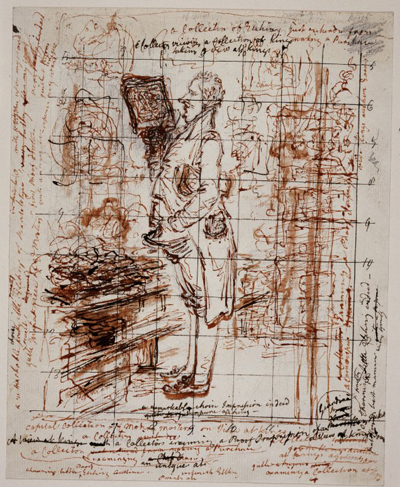Gillray's Techniques

© Lewis Walpole Library, Yale University
Preparation
Gillray's designs sometimes have such a manic exuberance that it is easy enough to believe the oft-repeated story that he would create directly on the copper and that his hands would be bloodied from cuts from the copper shavings produced in the heat of this feverish activity. But there are a number of reasons for regarding this story with some skepticism, not the least of which is the existence of sketches and preparatory drawings in the British Museum, Lewis Walpole Library, and elsewhere.
It is more likely, then, that like most artists, Gillray would have begun by sketching out his ideas in rough form and have proceeded to etching and engraving only after the concept and arrangement were mostly fixed. In the "[Sketch of a robed man]" from the Lewis Walpole Library at right, for instance, we can see Gillray working out a design, arranging figures, and making notes to himself. If, as the curators at the Library believe, this drawing is a preliminary study for the print entitled End of the Irish Farce of Catholic Emancipation, this particular concept never got beyond the rough draft stage, for none of the figures in the drawing appear in the final print or in any other known print of Gillray's.
In some of his earlier or simpler caricatures where there were fewer figures
to arrange across the space and fewer techniques being used to create depth and shading, the preparatory
sketching process may have been fairly brief. It is certainly true that, unlike Rowlandson, Gillray seems to
have been able to draw on copper without any loss of vitality. But in elaborate prints like Shakespeare Sacrificed, or The Offering to
Avarice, or in the Union Club which serves as the banner for this web site, Gillray must have spent
considerable amounts of time in planning. And since Gillray's work nearly always depended upon caricatures of
specific individuals, he would, at minimum, have made preliminary sketches of the individuals portrayed,
especially if they were new to his repertoire.

Connoisseurs Examining a Collection of George Morland's] [1807]
© Trustees of the British Museum
In the drawing on the right, for instance, Gillray has sketched out the figure of Mr. Baker much as he appears in the final print of Connoisseurs Examining a Collection of George Morland's but he has also included grid lines so that he can more easily transfer the sketched figure to the final print, or, as is likely in this case, to a more complete sketch with additional figures. The more complete sketch would then have been used to create the final print.
There are preliminary drawings of Gillray's with grid lines like these in the British Museum, Frick Gallery, New York Public Library, and Fitzwilliam Museum. In addition to trying out individual figures before combining them, Gillray may also have used the grid lines to scale up or down a sketch that he made in a more comfortable size.